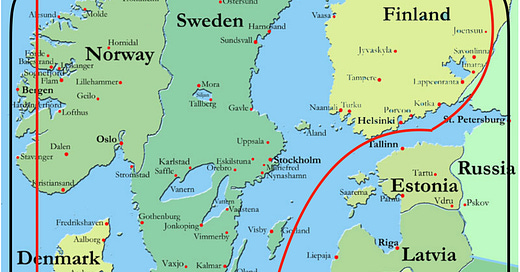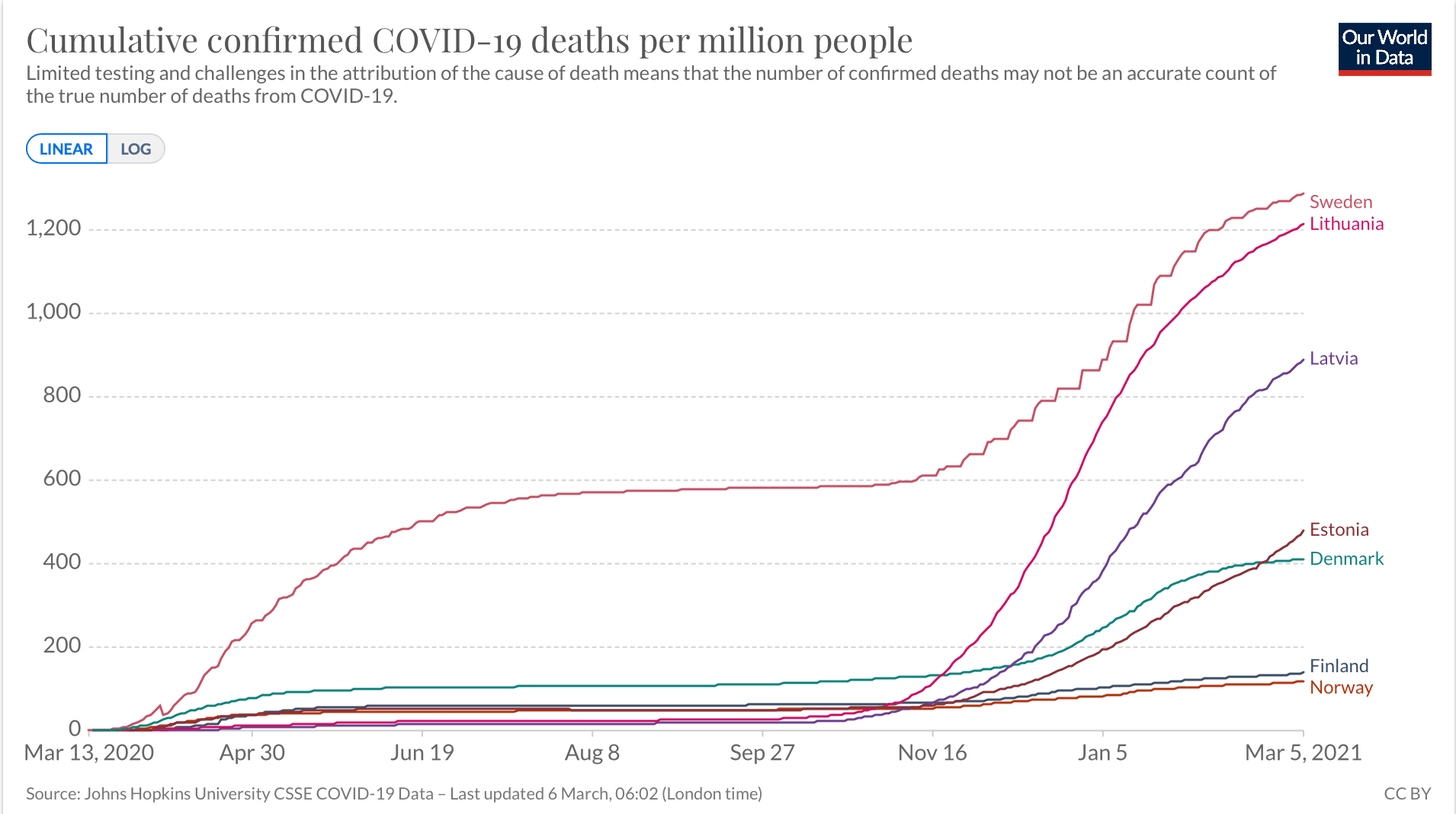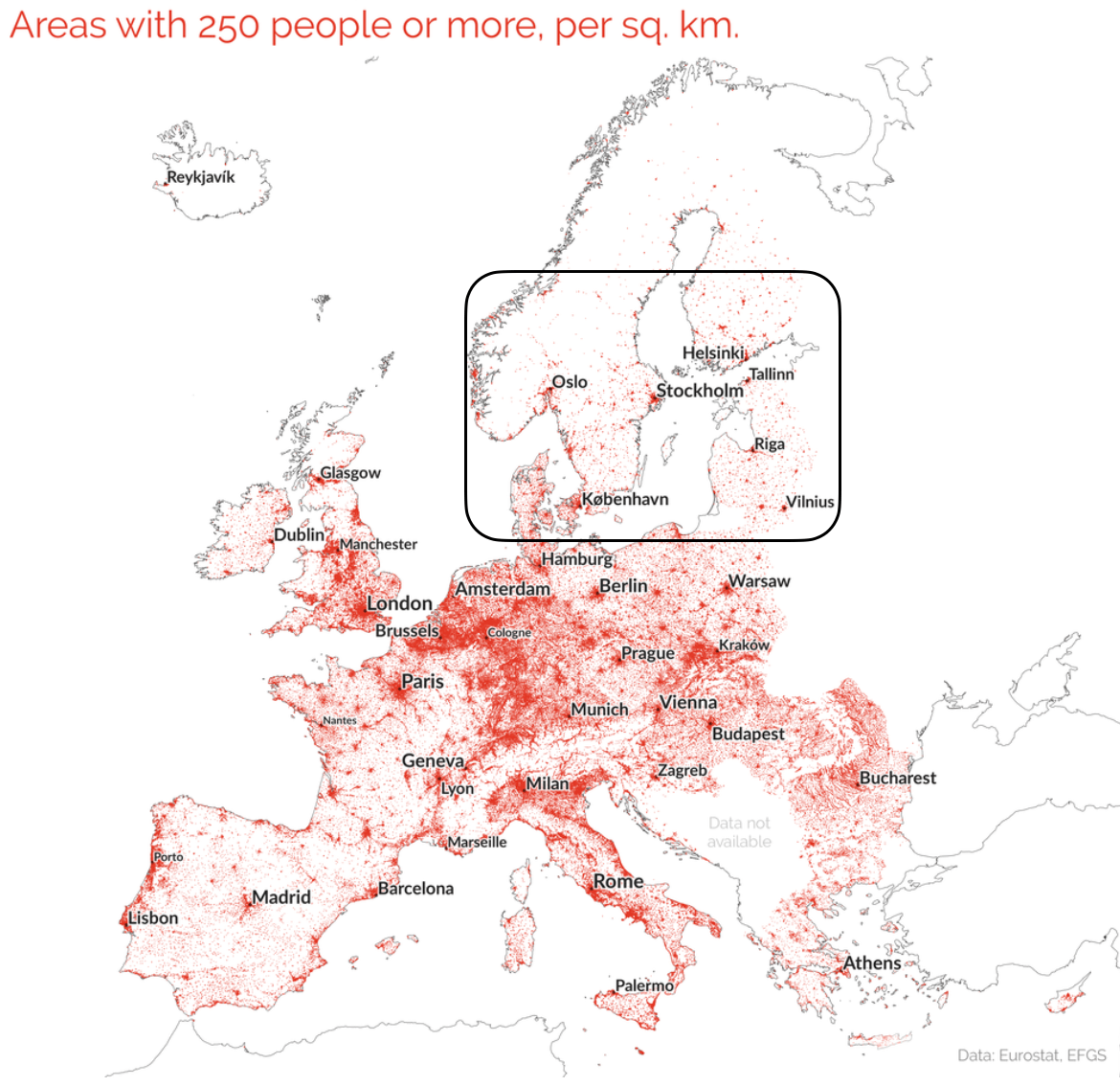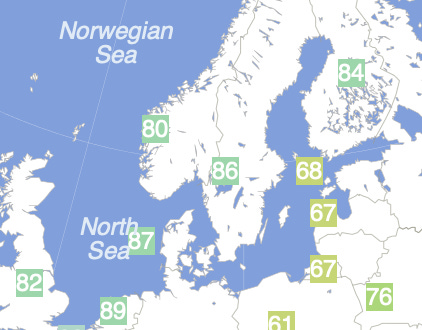The Nordics and the Baltics
Comparing Sweden with other Nordic countries does not prove lockdown works
Sweden is the test case for whether lockdowns are necessary to combat the pandemic. When the rest of Europe adopted China’s lockdown policy last March, Anders Tegnell, Sweden’s state epidemiologist, followed the pandemic planning in place before 2020, with recommendations for working from home and social distancing, but little in the way of legal restrictions. He was able to resist condemnation from the global media and many experts in part because of a principle of Swedish law that protects the decisions of appointed officials from interference by politicians.
Tegnell’s strategy has succeeded thus far. Sweden’s Covid-19 mortality rate is in line with the European average, which it achieved while avoiding many of the costs of lockdowns—to mental health, children’s education, etc—and suffering less economic damage than most European countries.
Despite this, many contend that Sweden failed because it has a much higher Covid mortality rate than its Nordic neighbours—Norway, Finland, and Denmark—and this is due to its failure to lock down. I call this the Neighbour Argument, and in this post I try to show why it is wrong.
One reason is that once you include the Baltic countries (lying immediately south of Finland) in the geographic comparison, Sweden is no longer an outlier in mortality comparisons. As the charts above and below show, Sweden’s death rate is the highest in the region but only slightly higher than Lithuania’s. Norway and Finland are outliers—much lower than every other country in Europe—while the Baltics and Denmark span the mid to lower range.
The Neighbour Argument is very widespread. Anyone on social media who invokes Sweden to contend that lockdowns are not necessary knows that any such claim will inevitably be attacked with the Neighbour Argument. The argument is also used independently to demonstrate the need for lockdowns. Neil Ferguson, whose pandemic modelling was a key influence on the UK’s decision to abandon its initial approach that resembled Sweden’s, relies on the Neighbour Argument to defend the lockdowns he urged on the UK (and the world).
Sweden made one set of choices, Denmark and Norway another. The result is that Sweden has had fewer restrictions overall, but has had 3-4x the per capita death toll of its neighbours. [The UK’s] death toll is higher still not because we over-reacted, but because we introduced measures too late last March, and then repeated the mistake last autumn. And because of factors which were just bad luck—the level of seeding last February and the new variant last November.
Neil Ferguson
This claim about Sweden’s failure to lock down—made by Ferguson in late February—would have had an initial plausibility in summer last year. At that time Sweden had one of the highest national mortality rates in the world, and it was noticeably much higher than all three of its Nordic neighbours. Charts like this from late July were ubiquitous at the time, and many took the lesson to be that failure to lock down leads to disaster.
The apparent success of Denmark, Norway, and Finland in locking down and keeping mortality low was replicated throughout central Europe and the Baltics. As Tegnell said, however, getting through a pandemic is “a marathon, not a sprint”. Judge me in a year, he said last July, claiming it was the rest of the world, not Sweden, that was engaging in a novel experiment in pandemic control.
As we near the one-year anniversary of lockdowns, the picture is now very different. In the first place, among Sweden’s three Nordic neighbours a large gap has emerged as Denmark’s mortality has climbed. Ferguson, in the quote above, claimed that Sweden’s mortality rate was 3-4 times higher than Denmark and Norway, but in fact Denmark itself now has 3-4 times the deaths of Finland and Norway. Using Ferguson’s own metric, one must conclude that Denmark’s higher mortality is due to its failure to manage lockdown correctly.
More telling, however, is including the Baltic countries in the regional comparison. All three emerged from the first wave with very low mortality, but Lithuania has now come close to Sweden. Latvia is closing in on 1000 deaths per million, and Estonia is keeping pace with Denmark, well above Finland and Norway.
The Baltics followed the standard lockdown prescription more closely than Finland, Norway, and Denmark. Considering the geographic and demographic similarity of the Baltics to the Nordics, it is illogical to argue that Sweden’s failure to lock down was responsible for its higher Covid mortality than the Nordics. Lithuania and Latvia also have much higher Covid mortality than their regional neighbours, despite locking down more stringently. (Finland, after locking down in the spring, remained open in the fall and winter, albeit with strict border controls.) The logical flaw here is cherry-picking, the fallacy of incomplete evidence. One cannot rely on a Nordic-only comparison chart to demonstrate the efficacy of lockdown and ignore the above Nordic-Baltic chart.
In their populated areas, as the map below indicates, the Baltics have a similar density to Sweden, Finland, and Norway, while Denmark is somewhat more dense than the rest. The main populated region of the Nordics (setting aside the large, mostly empty northern tracts) and Baltics forms an even square. To cordon off the Baltics from the Nordics, one has to draw a curved line like gerrymandered electoral districts in the US.
It might be objected that the Baltics are different because they were under Soviet control, unlike the Nordics. But that ended almost 30 years ago, and the Baltics reached the level of development needed to join the European Union and NATO by 2004. Lithuania and Latvia have slightly lower GDP per capita than Spain.
The Baltics have, in the second wave, followed the general trend of Europe. Neil Ferguson, in the influential Imperial College report of 16 March 2020, made this prediction: “The more successful a strategy is at temporary suppression, the larger the later epidemic is predicted to be in the absence of vaccination, due to lesser build-up of herd immunity.” That is one thing he seems to have got right. Several central European countries have now surpassed Sweden in mortality. Czechia, once hailed as a model for its early adoption of lockdown and masking, has the highest Covid mortality rate in Europe.
It is becoming increasingly difficult to doubt Sweden’s success. Its Covid-19 mortality rate is in line with the European average and well below the European average for all-cause excess mortality, according to a report by the Oxford Centre for Evidence-Based Medicine. Excess mortality in Sweden in 2020 was elevated in comparison to the unusually low-mortality year of 2019, but 2020 was historically unexceptional and no higher than 2012.
The Neighbour Argument, as we have seen above, has been largely discredited due to the developments in the fall and winter in the Nordic-Baltic region. But even in the summer the argument failed to take seriously the logic of Sweden as a control group. In early August, although Sweden’s national mortality rate was among the top ten in the world, it was lower than several countries that locked down, including Belgium, Italy, Spain, and the UK, as well as New York and 11 other US states. Consider all this a clinical trial, with the inhabitants of lockdown countries taking the drug of lockdown and 10 million Swedes taking the placebo of remaining open. Sweden’s better performance than 16 other European and US states is strong prima facie evidence that the drug is not effective, regardless of how Sweden performed in comparison to its immediate neighbours. Sweden’s performance relative to Europe is matched in the US by Florida, where Governor DeSantis decided to follow Tegnell’s lead and started dropping lockdown measures in June; and several studies support the conclusion that lockdown is not effective.
As time has elapsed, Sweden has continued to climb down the mortality tables. It is now lower than 19 countries in Europe and 33 US states. Sweden’s Covid mortality remains significantly higher than Norway’s and Finland’s, and there have been various attempts to explain this, pointing to factors such as Sweden having a larger vulnerable population going into 2020 because of a mild flu season and unusually low mortality in 2019. But the larger question now is not why Norway and Finland are lower than Sweden, but why they are so much lower than all countries in Europe and all 50 US states. Why they are such outliers is a genuine curiosity. Whatever the explanation, this post has shown that their lower mortality does not prove the efficacy of lockdowns.
POSTSCRIPT: The Neighbour Argument is based on the premise that countries which are geographically and demographically similar are expected to have similar outcomes for Covid-19 mortality in the absence of other explanatory factors. I have accepted that premise in this post for purposes of responding to the argument. But it is questionable how far one should initially expect similar outcomes based on such similarities, especially when looking to variation in lockdown or other NPIs (non-pharmaceutical interventions) as the main factor to explain different outcomes. Comparing outcomes in different countries inherently involves many complex factors, and even within single countries (Italy, for example) there can be dramatic differences in mortality between regions. In particular, there are different views on whether and how population density affects outcomes. Some say it has little effect, while others claim Sweden’s higher-density cities partly explain lower mortality in Norway and Finland. One study found that a city’s metropolitan size and connectivity leads to higher mortality but density per se does not. While Sweden has low population density per square kilometre, it has a more highly urbanised population than the UK; the other Nordics are similar. The Baltics are less urbanised than the Nordics, but as the population density map above shows, most of the Nordic-Baltic region has a relatively low density.
In any event, country comparisons should not be a kind of macabre Coronalympics in which one picks out who had the winning strategy and technique based on the country’s placement in Covid mortality tables. The point of comparing Sweden to Europe and pointing out its average Covid mortality is to show that it was possible to reject lockdown policy and get through the pandemic without suffering anything like the dire consequences that Ferguson and other modellers predicted in the absence of lockdown.













Excellent article, thank you. A case for the policy of "herd immunity" has recently been made by this study conducted on U.S. Marines - a very controlled environment, so to speak: https://greatamericanpolitics.com/2020/11/marines-experiment-shows-covid-quarantines-have-no-effect-on-virus-spread/
Neither Norway nor Finland have had a lockdown, going by the agreed definition, as neither has implemented a stay-at-home order or a restriction on household mixing. So they are both examples of success in handling the pandemic despite very light government restrictions.